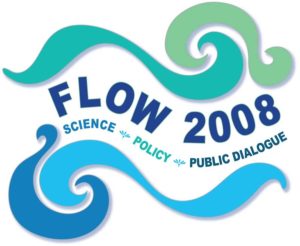Conference Program
In the interest of saving paper, and due to the unique program employed for this conference, no standard “Proceedings” document was produced. Instead, the text below describes the main elements of the conference and includes links to electronic versions of the various and diverse conference products.
In October 2008, the Instream Flow Council held FLOW 2008: Interdisciplinary Solutions to Instream Flow Problems, in San Antonio, TX, which attracted over 330 instream flow practitioners and stakeholders. The conference was a mix of presented papers from invited speakers, interactive sessions, a poster session, and exhibitors. Below is a short summary of the conference, including links to various conference products. Some of the links are to very large files, so we encourage the reader to skim the information below to their satisfaction before accessing the linked documents. Please see the conference program for more detail on conference sessions.
A cadre of expert trainers provided three pre-conference technical workshops on; generating high-flow prescriptions, the MesoHABSIM modeling tool, and The Nature Conservancy’s environmental flow tools. The sessions were filmed and workshop videos are available for download
The main conference began with a negotiation training session. Crafted by Professor Larry Susskind and Cat Ashcraft at MIT with the assistance of the FLOW 2008 Planning Team, the Long River interactive role-playing session helped introduce and explore stakeholder communication and negotiation techniques. The mythical (but believable) Long River was experiencing growth and land use change, with concomitant water allocation issues and instream flow challenges. Conference participants were asked to review the Long River background information in advance, then were assigned one of six roles, each with confidential instructions on the specific interests of the role. They spent two hours representing their role, reported back, and Larry’s team summarized the collective results.
Former State Legislator Robert Puente gave the luncheon keynote address, and provided his outline for future reference. Brian Richter (The Nature Conservancy) then moderated the State of the Art panel made up of Geoffrey Petts (University of Westminster), Larry MacDonnell (University of Wyoming), and Mark Smith (The Nature Conservancy). The discussion focused on the four papers drafted in advance – an introduction, and three papers respectively on the state of the art of instream flow science, policy and public dialogue. These papers were published as a “featured collection” in the Journal of the American Water Resources Association.
Nina Burkardt (USGS) and Tom Annear (Wyoming Game and Fish) helped set the stage for the subsequent interactive conference sessions by presenting results of the pre-conference survey and IFC’s International Instream Flow Program Initiative. The program then alternated between case study panels and interactive Action Planning strategizing sessions. Andrew Paul (Alberta Sustainable Development) moderated Case Study Panel #1, which began with Marty Kelly (SE Florida Water Management District) providing an overview, and Lisa Beever (Charlotte Harbor National Estuary) providing her perspective, on the instream flow work on the Peace River in Florida. The presentations continued with Dan Ohlson (Compass Resources) providing an overview, and Mel Sheng (DFO-Canada) providing his perspective, on the Campbell River Water Use Planning process in British Columbia. A lively discussion followed, with the benefits (and sometimes discomforts) of the interplay of science and stakeholder interests in public decision-making being a common theme. Case Study Panel #2, moderated by Peter Aarrestad (Connecticut DEP), focused on the instream flow aspects of the Housatonic hydro relicensing process, with Melissa Grader (USFWS) providing the overview and Bob Gates (FirstLight Power Resources) providing his perspective. They were followed by Ann Bleed (NE DNR-retired) providing an overview, and Don Krause (Central NE Public Power and Irrigation District) providing a perspective, on the Platte River’s history and status related to instream flow issues and efforts.
During lunch on Wednesday, IFC issued its first-ever awards – three “Making a Difference” awards to Don Orth, Christopher Estes, and Don Tennant, and a “Lifetime Achievement“ award to Clair Stalnaker.
The Action Planning sessions were intended to mobilize the expertise and interests of the participants in various strategizing sessions (including 5 regional breakout groups) to generate an Action Plan that all could own and pursue in their work and advocacy in the future. Professor Susskind and a cadre of regional and assistant facilitators helped convert a multiplicity of ideas into a coherent draft Action Plan, endorsed by most attendees. As the last step in the process, participants provided hand-written comments on their copies, which IFC later summarized as the final FLOW 2008 Action Plan. Only comments that “clarified” elements of the draft were incorporated. Since the remaining comments are also valuable, a “long version” was also generated and retained.
The banquet at the legendary Buckhorn Saloon, provided opportunities to view the interesting museum collections, enjoy Texas cuisine, and be inspired by the banquet keynote speaker Charles Wilkinson (University of Colorado).
A poster session (view abstracts) added to the diversity and format of the conference, and provided opportunities to explore 21 additional topics and case studies with knowledgeable experts. And an exhibitors session provided yet additional opportunities for participants to display their wares, discuss their services, and showcase their programs. Sandra Postel provided an inspiring closing keynote to send the attendees on their way to address water allocation challenges with new tools, ideas, and colleagues from FLOW 2008.
IFC is thankful to all those who contributed to the planning and implementation of this conference, including the Planning Team, Advisory Committee, generous sponsors, speakers and moderators, and all the participants who came and contributed their time and knowledge. The local hosting from the Texas Parks and Wildlife Department was expert and critical to conference success. We hope the alliances formed and resources shared at the conference will prove helpful in promoting sound management of our finite and ever more valuable waters and aquatic ecosystems.
Last Updated May 13, 2019
